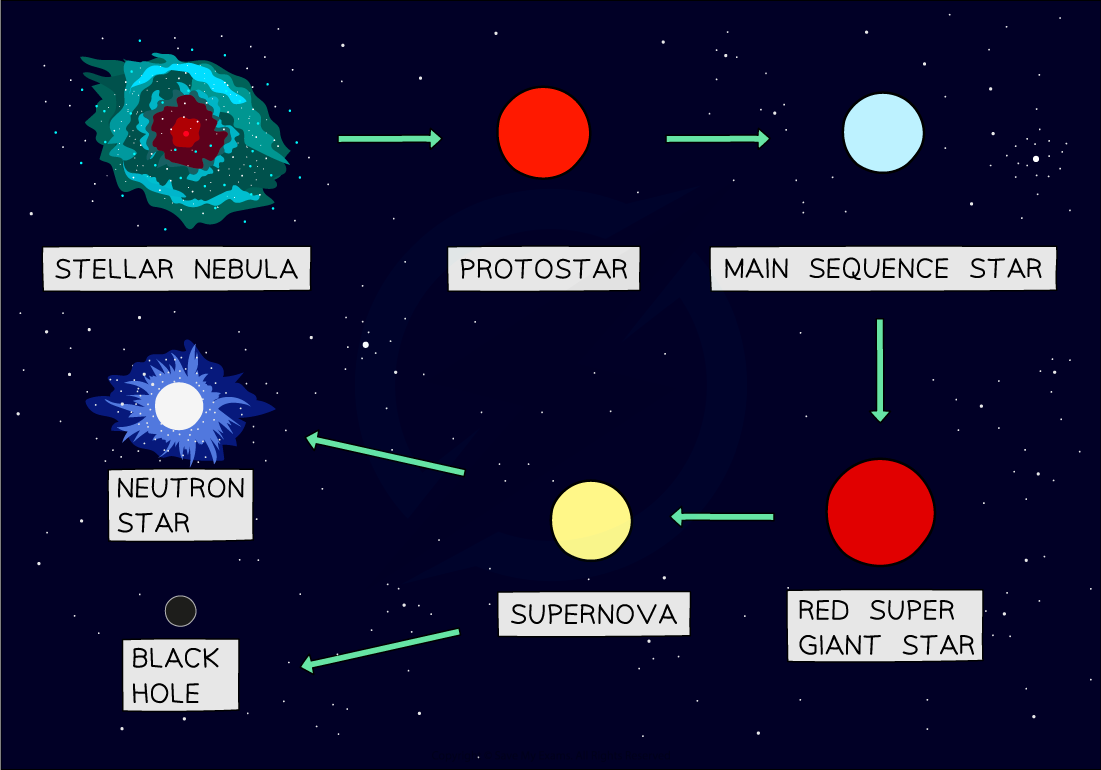Lifecycle of a Star
1. Nebula
- All stars form from a giant cloud of hydrogen gas and dust called a nebula
2. Protostar
- The force of gravity within a nebula pulls the particles closer together until it forms a hot ball of gas, known as a protostar
- As the particles are pulled closer together the density of the protostar will increase
- This will result in more frequent collisions between the particles which causes the temperature to increase
3. Main Sequence Star
- Once the protostar becomes hot enough, nuclear fusion reactions occur within its core
- The hydrogen nuclei will fuse to form helium nuclei
- Every fusion reaction releases heat (and light) energy which keeps the core hot
- Once a star is born it is known as a main-sequence star
- During the main sequence, the star is in equilibrium and said to be stable
- The inward force due to gravity is equal to the outward pressure force from the fusion reactions
- Once a main sequence star is formed, its life cycle will depend on its mass
- The different life cycles are shown below:


Flow diagram showing the life cycle of a star which is the same size as the Sun (solar mass) and the lifecycle of a star which is much bigger than the Sun
Lifecycle of a Star About the Size of The Sun (A Solar-mass Star)
4. Red Giant
- After several billion years the hydrogen causing the fusion reactions in the star will begin to run out
- Once this happens, the fusion reactions in the core will start to die down
- This causes the core to shrink and heat up
- The core will shrink because the inward force due to gravity will become greater than the outward force due to the pressure of the expanding gases as the fusion dies down
- A new series of reactions will then occur around the core, for example, helium nuclei will undergo fusion to form beryllium
- These reactions will cause the outer part of the star to expand
- It will become a red giant
- It is red because the outer surface starts to cool
5. Planetary Nebula
- Once this second stage of fusion reactions have finished, the star will become unstable and eject the outer layer of dust and gas
- The layer of dust and gas which is ejected is called a planetary nebula
6. White Dwarf
- The core which is left behind will collapse completely, due to the pull of gravity, and the star will become a white dwarf
- The white dwarf will be cooling down and as a result, the amount of energy it emits will decrease
7. Black Dwarf
- Once the star has lost a significant amount of energy it becomes a black dwarf
- It will continue to cool until it eventually disappears from sight

The lifecycle of a solar mass star
Lifecycle of a Star Much Larger than The Sun
- A large star is one which is bigger than the Sun
- Stars that are larger than the Sun have much shorter lifespans - in the region of hundreds of millions of years (instead of billions)
- This is because they burn through the fuel in nuclear fusion much quicker than smaller stars
- The life cycle of a star bigger than the Sun starts in the same way as a solar mass star
1. Nebula
2. Protostar
3. Main Sequence Star
- Steps 1-3 (nebula, protostar and main sequence star) are the same for all masses of star
4. Red Supergiant
- Eventually, the main sequence star will reach a stage when it starts to run out of hydrogen gas in its core
- Once this happens, the fusion reactions in the core will start to die down
- This causes the core to shrink and heat up
- The core will shrink because the inward force due to gravity is greater than the outward force due to the pressure of the expanding gases
- A new series of fusion reactions will then occur around the core, for example helium nuclei will undergo fusion to form beryllium
- These fusion reactions will cause the outer part of the star to expand and it will become a super red giant
- A super red giant is much larger than a red giant
5. Supernova
- Once the fusion reactions inside the red supergiant finally finish, the core of the star will collapse suddenly causing a gigantic explosion
- This is called a supernova
- At the centre of this explosion a dense body, called a neutron star will form
- The outer remnants of the star will be ejected into space during the supernova explosion, forming a planetary nebula
6. Neutron Star (or Black Hole)
- In the case of the biggest stars, the neutron star that forms at the centre will continue to collapse under the force of gravity until it forms a black hole
- A black hole is an extremely dense point in space that not even light can escape from

Lifecycle of a star much larger than our Sun
Examiner Tip
The term nebula in astronomy refers to any cloud of gas or dust. The nebulae that form stars are made from hydrogen, whilst the ones that are formed when stars die (planetary nebula) are made from much heavier elements, such as helium.
You need to memorise the lifecycle for each size of star!

